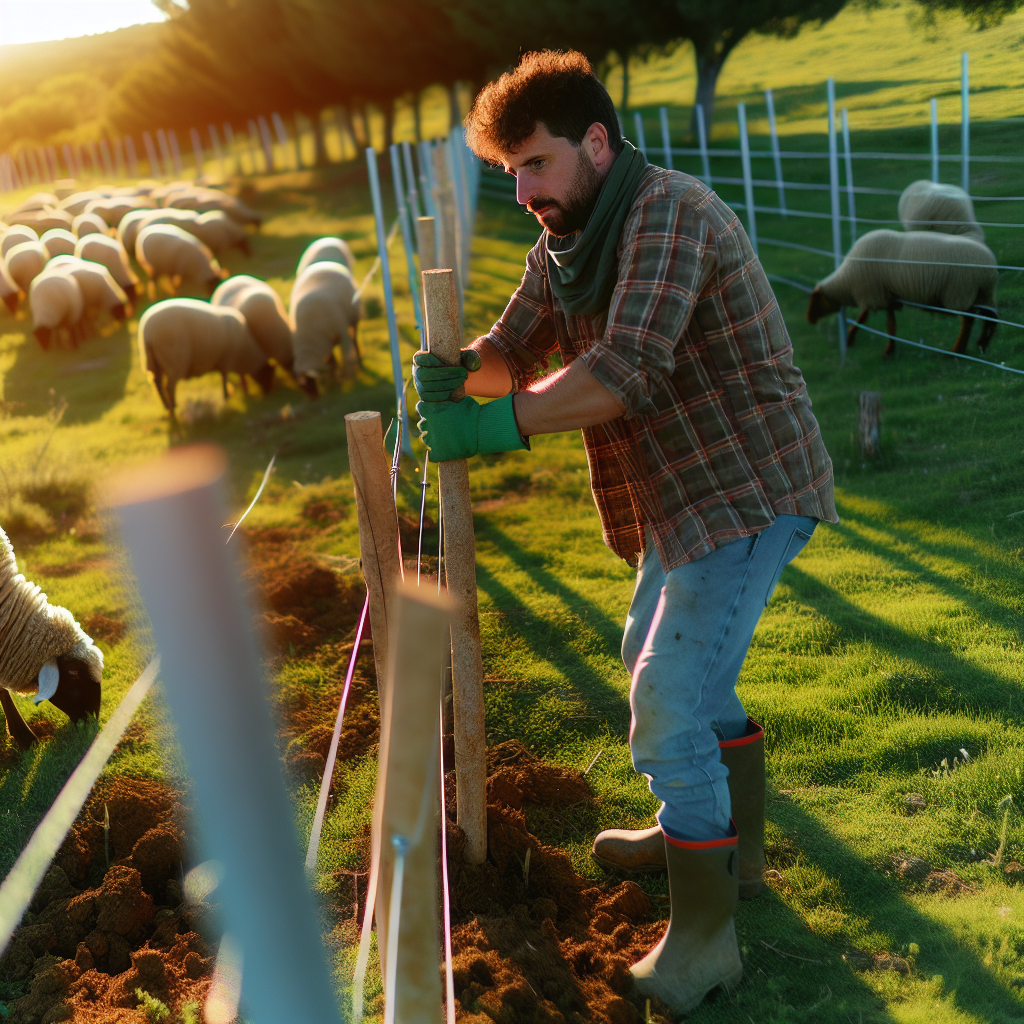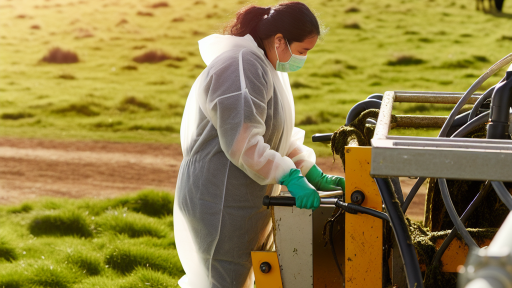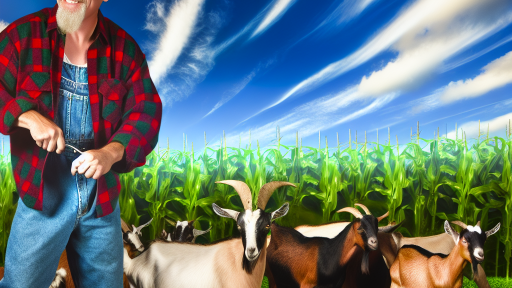Introduction to Sustainable Fencing
Importance in Sheep Farming
Sustainable fencing plays a vital role in sheep farming.
It promotes animal welfare and protects the environment.
Moreover, it enhances farm productivity and efficiency.
Farmers can utilize eco-friendly materials for fencing.
This choice supports local economies and resource conservation.
Additionally, sustainable fencing methods reduce maintenance costs.
Benefits of Sustainable Fencing
Eco-friendly fencing offers numerous benefits.
First, it minimizes carbon footprints related to livestock management.
Second, it protects water sources from contamination.
Third, sustainable fencing encourages biodiversity across pastures.
Farmers can select biodegradable or recycled materials.
These choices enhance soil health through natural processes.
Types of Sustainable Fencing Solutions
Farmers should consider various sustainable fencing solutions.
- Wooden fencing from sustainably managed forests.
- Electric fencing that conserves energy efficiently.
- Natural barriers like hedgerows for shelter and food.
- Wire fencing made from recycled materials.
Implementing Sustainable Practices
Implementing sustainable fencing requires proper planning.
Farmers should assess their land and sheep behavior.
Transform Your Agribusiness
Unlock your farm's potential with expert advice tailored to your needs. Get actionable steps that drive real results.
Get StartedEffective layout enhances sheep movement and pasture use.
In turn, this supports efficient grazing patterns.
Monitoring and adapting fencing based on needs is crucial.
Case Studies in Sustainable Fencing
Several farms have successfully adopted sustainable fencing.
Sunny Meadows Farm uses electric fencing to manage rotations.
Big Oak Ranch relies on natural hedgerows for boundary limits.
These practices show improved sheep health and reduced input costs.
Farmers can learn valuable lessons from these successes.
Community Engagement and Support
Successful implementation requires community involvement.
Farmers should join local co-ops for shared resources.
Workshops on sustainable practices also promote collaboration.
Support from environmental organizations can provide funding.
Lastly, sharing experiences builds a stronger farming community.
Types of Sustainable Fencing Materials for Sheep Pens
Natural Wood Fencing
Natural wood offers an aesthetic and ecological advantage.
It comes from sustainably managed forests, reducing environmental impact.
Additionally, wood absorbs carbon dioxide over its lifespan.
Hardwood options, like oak and cedar, provide durability.
However, regular maintenance is essential to prevent decay.
Recycled Plastic Fencing
Recycled plastic fencing represents an innovative alternative.
This material is created from post-consumer waste, promoting recycling.
Furthermore, it is resistant to rot and pests, offering longevity.
It requires minimal upkeep, which can reduce labor costs.
Moreover, plastic fencing typically comes in various colors and designs.
Livestock Panels
Livestock panels made from metal also serve as sustainable solutions.
Showcase Your Farming Business
Publish your professional farming services profile on our blog for a one-time fee of $200 and reach a dedicated audience of farmers and agribusiness owners.
Publish Your ProfileThey are durable and can withstand harsh weather conditions.
Metal is recyclable, helping to reduce landfill waste.
Additionally, these panels are easy to assemble and disassemble.
However, they may require more upfront investment compared to other options.
Bio-Fencing
Bio-fencing utilizes living plants to create natural barriers.
Hedgerows or thorny bushes can deter sheep from wandering.
This method promotes biodiversity and enhances aesthetics in the landscape.
Furthermore, bio-fencing improves soil health through root systems.
Overall, it integrates well into organic farming practices.
Geotextile Fencing
Geotextile fencing offers a unique and forward-thinking approach.
This material consists of layers of fabric soaked in natural preservatives.
It provides durability without harming the environment.
Additionally, geotextile fencing supports soil retention and erosion control.
Therefore, it serves multiple purposes on a farm.
Evaluating the Environmental Impact of Fencing Solutions
Importance of Sustainable Fencing
Sustainable fencing plays a crucial role in livestock management.
It minimizes environmental damage while ensuring animal welfare.
Additionally, these solutions can enhance the overall ecosystem.
Material Selection
The choice of materials greatly influences sustainability.
Natural and biodegradable materials are preferable.
Wood from responsibly managed forests reduces carbon footprints.
Metal fencing, when recycled, can also be a sustainable option.
Installation Practices
Proper installation techniques prevent soil erosion.
Using minimal heavy machinery lessens the ground disturbance.
Employing trenching methods can further protect the surrounding habitat.
Long-term Impact Assessment
Evaluating the long-term impact is essential for sustainable practices.
Monitoring the effects on local wildlife is necessary.
Also, assessing changes in pasture utilization helps in effective management.
Integration with Ecosystem
Fencing should facilitate the natural movement of wildlife.
Wildlife corridors can reduce fragmentation in habitats.
Additionally, thoughtful design promotes biodiversity within the fenced area.
Community Involvement
Engaging local communities in the fencing process is vital.
Education about sustainable practices fosters cooperation.
Collaboration can lead to innovative solutions that benefit all.
Recommendations for Sustainable Fencing Practices
Evaluating the environmental impact of fencing is ongoing.
Continual improvements in practices can yield better results.
Through effective strategies, we can promote sustainable sheep farming.
Discover More: Weight Gain Techniques for Beef Cattle
Cost-Effectiveness of Sustainable Fencing for Sheep Farmers
Initial Investment Considerations
Sustainable fencing requires a careful assessment of upfront costs.
Farmers must analyze material options and labor expenses.
Choosing locally sourced materials can reduce costs significantly.
Showcase Your Farming Business
Publish your professional farming services profile on our blog for a one-time fee of $200 and reach a dedicated audience of farmers and agribusiness owners.
Publish Your ProfileAlternative materials like bamboo or recycled plastic are viable choices.
In some cases, government grants may offset initial expenditures.
Long-Term Savings
Investing in sustainable fencing can lead to substantial long-term savings.
Durable materials often require less maintenance over time.
This reduction in upkeep translates to lower labor costs.
Furthermore, sustainable fencing minimizes livestock losses.
Farmers can save on replacements and veterinary bills associated with escape attempts.
Environmental Impact and Financial Incentives
Using eco-friendly fencing can attract financial incentives.
Many programs reward sustainable farming methods financially.
Farmers might receive tax breaks for opting for sustainable solutions.
In addition to financial aid, sustainable practices enhance public perception.
Producers can appeal to increasingly eco-conscious consumers.
Advantages of Sustainable Fencing
The cost-effectiveness of sustainable fencing is compelling.
Farmers benefit from reduced long-term expenses while contributing positively to the environment.
Ultimately, sustainability can be both economically advantageous and morally fulfilling.
Learn More: Selecting Breeds for Exotic Livestock Success
Best Practices for Installing and Maintaining Sustainable Fences
Choosing Sustainable Materials
Select materials that are renewable and sourced responsibly.
Use locally sourced wood to reduce transportation emissions.
Consider alternative materials such as bamboo or recycled plastic.
Opt for natural fencing options to enhance habitat for wildlife.
Effective Installation Techniques
Plan your fencing layout before beginning installation.
Mark the posts clearly to ensure proper spacing.
Dig post holes deep enough for stability and longevity.
Use eco-friendly fasteners to minimize environmental impact.
Regular Maintenance Practices
Inspect your fence regularly for signs of wear and damage.
Clean fencing materials to prevent deterioration.
Replace any damaged parts promptly to maintain effectiveness.
Utilize natural sealants to protect wood from the elements.
Managing Vegetation Around Fences
Keep vegetation trimmed around the fence line.
This prevents damage from plants growing into the fence.
Promote native plants that support local wildlife habitats.
Regular maintenance of vegetation promotes fence longevity.
Community Engagement and Education
Engage with local communities about sustainable practices.
Share knowledge on the benefits of sustainable fencing.
Encourage neighbors to adopt similar practices for a collective impact.
Attend workshops to learn more about eco-friendly solutions.
Uncover the Details: Record Keeping Tips for Sheep Farmers

Integrating Natural Barriers with Fencing: Pros and Cons
Understanding Natural Barriers
Natural barriers include hedgerows, trees, and shrubs.
These elements create a distinct boundary for sheep.
They also enhance the landscape and biodiversity.
Showcase Your Farming Business
Publish your professional farming services profile on our blog for a one-time fee of $200 and reach a dedicated audience of farmers and agribusiness owners.
Publish Your ProfileBenefits of Integrating Natural Barriers
Integrating natural barriers reduces the need for traditional fencing.
This method is often cost-effective and environmentally friendly.
Additionally, natural barriers provide shelter for sheep during harsh weather.
Moreover, they can support local wildlife and promote biodiversity.
Using natural barriers can improve the aesthetic appeal of the farm.
Challenges of Utilizing Natural Barriers
Establishing natural barriers may require significant upfront investment.
There may also be maintenance challenges over time.
Natural barriers can attract pests that affect sheep health.
Furthermore, some natural barriers have slower growth rates than anticipated.
Lastly, they may not provide sufficient containment in certain situations.
Balancing Fencing and Natural Barriers
A blended approach can maximize the advantages of both options.
This includes using traditional fencing alongside natural barriers for extra security.
Choosing the right combination depends on the specific farm’s needs.
The local climate and ecosystem should also influence decisions.
Consulting with agricultural experts can provide valuable insights.
Find Out More: Common Challenges in Livestock Handling Solutions
Case Studies: Successful Implementation of Sustainable Fencing
Farmers Adopting Innovative Techniques
In recent years, farmers have embraced innovative fencing techniques.
This shift focuses on using sustainable materials for fencing solutions.
George Thompson, a Texas rancher, exemplifies this approach.
He replaced traditional barbed wire with natural fencing made from local brush.
This change improved the landscape and reduced maintenance costs.
Community Initiatives and Support
Local communities are increasingly supporting sustainable practices.
In Oregon, the Sustainable Agriculture Coalition provides resources for farmers.
The coalition guided farmers through the transition to eco-friendly fencing.
They helped them select durable and natural materials.
As a result, participating farms saw a decrease in animal escapes.
Case Study: Eco-Fencing in Action
One exemplary case involves a farm in Colorado.
Mary Ellen Farms installed hemp-based fencing to enhance sustainability.
This method minimized plastic usage and was highly durable.
Furthermore, it provided better protection against predator attacks.
Feedback from the community confirmed increased wildlife activity nearby.
Educational Efforts and Awareness
Education plays a vital role in promoting sustainable practices.
Workshops and seminars foster awareness about eco-friendly fencing options.
Local universities often collaborate with ranchers for research.
This partnership leads to successful implementation of innovative techniques.
Consequently, more farmers adopt sustainable fencing solutions promptly.
Looking to the Future
As sustainability becomes crucial in agriculture, fencing evolves.
Future developments may include more renewable materials.
Additionally, in-field testing of new fencing designs will rise.
This will ensure continuous improvement in farm management practices.
Showcase Your Farming Business
Publish your professional farming services profile on our blog for a one-time fee of $200 and reach a dedicated audience of farmers and agribusiness owners.
Publish Your ProfileUltimately, successful case studies pave the way for broader adoption.
Future Trends in Sustainable Fencing for Sheep Farming
Innovative Materials
Farmers increasingly seek innovative materials for fencing solutions.
Biodegradable options, such as fencing made from recycled plastics, are gaining attention.
Additionally, natural materials like wood and bamboo are popular for their sustainability.
These materials often require less energy for production, reducing overall carbon footprints.
Smart Technology Integration
Smart fencing solutions are transforming sheep farming practices.
Farmers can monitor fencing conditions through apps connected to sensors.
These technologies provide real-time alerts for breaches or damages.
Moreover, they enhance herd management by tracking movements and behaviors.
Community Collaboration
Collaborative farming initiatives are reshaping fencing approaches.
Farmers are sharing best practices and resources to create sustainable solutions together.
This collaboration fosters innovation, making fencing more cost-effective.
Additionally, it strengthens community ties among local sheep farmers.
Eco-Friendly Installation Techniques
Installation techniques are evolving, focusing on eco-friendly methods.
For instance, minimizing soil disturbance during installation protects local ecosystems.
Further, using manual labor instead of heavy machinery reduces carbon emissions.
This shift leads to more sustainable fencing practices overall.
Regulatory Support
Governments are increasingly recognizing the need for sustainable farming practices.
They provide grants and incentives for farmers adopting eco-friendly fencing solutions.
This support encourages innovation while promoting environmental stewardship.
Furthermore, it enhances the visibility of sustainable practices within the community.
Additional Resources
“There will always be collars in my future”; Exploring US ranchers …
Researchers Design Virtual Fence Tech for Sustainable Animal …




